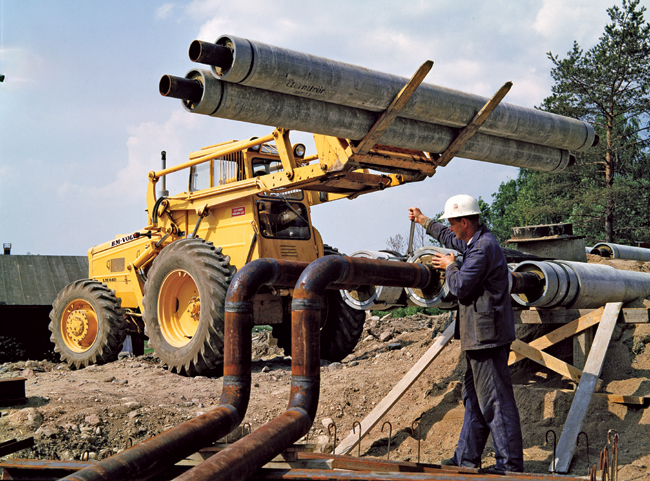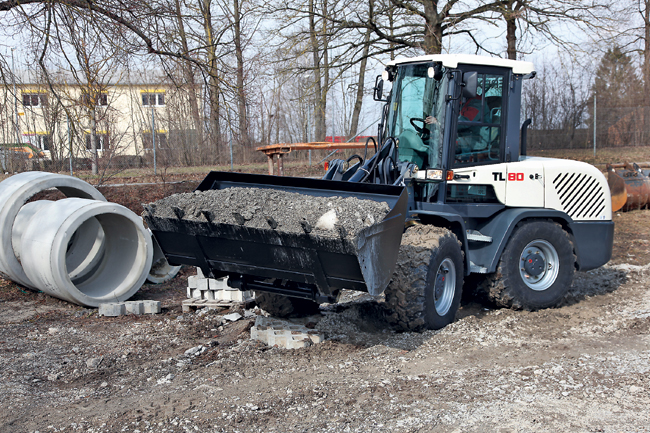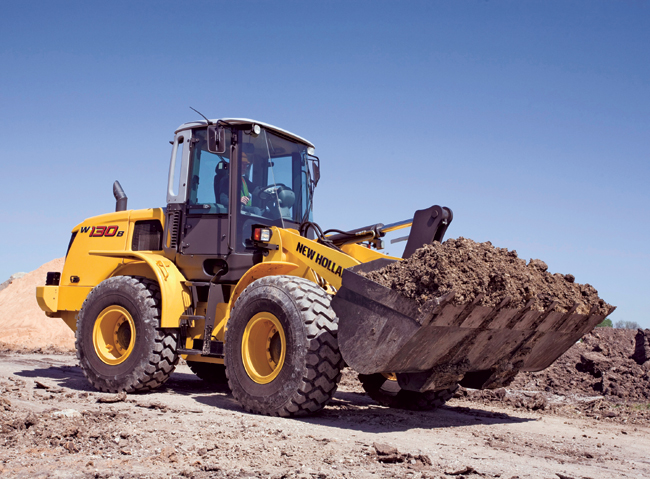Repowered and Reloaded
In today’s world of increased competition, high-stakes bids and shoe-string profit margins, a new piece of machinery might not be in the cards. But you still need metal to get the job done. Taking a look at your fleet, you notice the first wheel loader you ever bought. While it holds a special sentimental place in your fleet, it doesn’t see much action these days. With many machine manufacturers — from CNH to Terex to Volvo — supporting remanufacturing, that’s about to change. It’s time to teach that old material mover some new tricks.

Whether you’re looking to fix up an existing machine or you’re looking to save some green by buying a pre-owned machine, you have to give any out-of-commission wheel loader the same once over. Remember, this is construction equipment — abuse and normal wear and tear are two different things. The degree of the inspection largely depends upon the age of the machine and the reputation of the seller if you’re buying a pre-owned machine. An appropriate inspection of the machine should expose any potential problems or money pitfalls.
“The good operating condition and life expectancy of any compact wheel loader is largely influenced by regular care and maintenance,” says George Harrigan, Product Support Manager, Terex Construction Americas. “It is important to look at what components are failing and to determine why, how and when they failed. It is also important to know which components are holding up over time and to analyze those trends. Too often, the little things can be an indication of larger problems. Owners, operators and service technicians should never ignore these warning signs.”
For newer machines, a basic inspection should be sufficient, including checking the condition of tires, belts and hoses and looking for leaks, signs of damage or unusual wear and tear. For older machines with higher hours, oil and hydraulic fluid samples should be taken to check for any contaminants or system problems.
Common wear points such as hydraulic hoses, tracks and tires and the engine should also be inspected.
Scrapes and scuffs, chipping paint and rust are other red flags to look out for. The tell-tale signs of wear on a pre-owned wheel loader would be indicated by the condition of the bucket and frame pin and bushing, as well as checking the condition of the tires, tire pressure and tightness of the wheel nuts. The articulated steering linkage assembly, the brake functions and the function of all the safety devices should also be investigated.
“One of the things that is worth doing is starting the machine up and taking a look at the exhaust,” says Doug Phillips, Product Competency Manager for Volvo. “You can tell by the color of the exhaust if there is some kind of problem with the engine. If you’ve got a blue smoke, you’re pulling up some kind of oil. If you’ve got black, that’s always due to over fueling and it could also be a symptom of low compression. If you’ve got white, that’s a sign of raw fuel — either the ignition timing is off or there’s some problem with the fueling system.”
Much of the machine’s history guess work can be taken out of the equation by taking the machine to the dealer and running software diagnostic software that can tell you everything that has happened to that machine. This is offered by a number of manufacturers, including Volvo, and allows the potential buyer to see every time that machine displayed an error.
The purchase ultimately comes down to what you’re willing to spend vs. buying a new machine. Even if the engine is dead, you can purchase a remanufactured engine. Then again, a faulty articulation joint would call for separating the front and rear frames to rebore, rebearing and rebushing the joint. That’s somewhere in the realm of $15,000, according to Phillips.
“Although the price tag on a used wheel loader may be appealing, there are certain situations when the deal may just be too good to be true,” says Harrigan. “The major refurbishing points on a wheel loader are the piston/cylinder liners, bearings and fuel system. If buyers do their homework, they should have an idea about what kind of condition a machine should be in for it to run properly. Then they need to decide at what point the repair cost exceeds the budget. A buyer never wants to put more money into a piece of equipment than they will get out of it.”
Re-enlistment
The wheel loader has passed the initial inspection. It’s not pretty, but it will get the job done. It’s time to get this old machine up to its original standards. You start at the heart of the machine. In today’s economy, unless you’ve had a catastrophic failure in the engine block, it’s worth rebuilding the engine, says Phillips. If you’ve had a failure that has ruined some part of the engine block, then you might as well purchase a remanufactured engine. If not, then you can put in new liners and rotating assemblies — including cranks, rods and pistons — and check the fuel system and turbo as needed.
“Cylinder compression will be the starting point. This will help to determine if major work in required,” explains Troy Halverson, Product Support Team Leader for Wacker Neuson. “Low compression means the engine is in need of overhauling, which could be more than the unit is worth. If the engine is running fairly good checking the oil pressure and fuel system pressures will help determine if there is repair needed there. Low pressures here indicate worn components and future problems.”
Other engine areas to look at and listen to are the turbo, fuel injection system and the filtration system. With the engine running, look at the breather for excessive blow by, recommends John C. Harper, Parts and Service Senior Marketing Manager for CNH (Case Construction, New Holland Construction and Kobelco). This could indicate the need to rebuild or install a new reman’ed engine.
Moving down the remanufacturing and maintenance line, you’ll want to take a good look at the hydraulic system. One of the best ways to gauge the status of the hydraulic system is to run the machine. You’ll not only see what it’s capable of, but you’ll feel it as well.
For a more focused test, you can check the lift and drop time and steer-in. The manufacturer typically supplies the cycle time for lift and lowering the bucket and how long it takes for you to steer from a left-stop to right-stop. If the hydraulics are off, you’ll see the difference in the time. If there is a difference, you’ll want to hook the machine to pressure gauges to see how far off the mark the hydraulics are. And then you start checking for leaks — both external and internal.
“Some guys don’t understand an internal leakage,” says Phillips. “Let’s say you have a bucket full of dirt and you lift that boom up, the machine should idle with very little drop in the boom after a 10 minute period — it should not move over 6 or 7 mm. If the boom starts drifting down, then the O-rings in your cylinders are bad or some of the spools in your valves aren’t sealing correctly. If it’s not leaking out of the hose, you still have an issue.”
Usually, hoses, pumps and a rebuild of cylinders are the major repairs.
From there you might turn your attention to the loader’s namesake — the wheels. A tell-tale sign that the tires on a wheel loader need to be replaced are tread depth and side wall condition, says Harrigan. The condition of these two elements will determine the extent of remaining life or replacement necessity.
“Look for deep cuts, weather cracking and the lack of tread,” Halverson recommends. “These are items you do not want to skimp on, if you are in doubt about the tires, replace them.”
The wheels on a smaller, compact wheel loader are typically less expensive one-piece wheels — costing about $115 per wheel. When you get into mid-range or larger wheel loaders, the wheels are typically three-piece rims, which tend to run in the realm of $1,500 depending on the size and manufacturer.
“Usually, we don’t see anyone replacing the wheels on a wheel loader unless there’s some kind of damage on the steel or the locking legs,” says Phillips. “If there’s any kind of damage to the locking legs on a three-piece wheel, you need to replace it right away. That’s the only thing that holds that wheel together and if it gets a stress crack or anything in it, when you air it up, you run the risk of explosion.”
As always, safety first. You don’t want to skimp on any part of your refurbishing project. Skipping a vital step could cost you more in the long run or even possibly cause an injury. And that’s the last thing you want.
Emission Remission
Once you’ve got your machine back up to its original operating capacity or even if you have a slightly older machine that needs to meet emissions requirements, you might want to consider retrofitting your machine with a diesel particulate filter (DPF). In many areas, the biggest being California, New York and Cook County, Ill. (just outside of Chicago), running a Tier 3 or higher (or equivalent) machine is necessary for simply being able to bid the project.
“One question that we get from customers all the time is that if they install a particulate filter, will it make the machine a Tier 3 or Tier 4 emissions compliant?” says Phillips. “What they need to understand is that we’re catching the particulates, but we are not changing the Tier level — your NOx levels will not be changed by putting on a particulate filter.”
While adding a DPF to your wheel loader won’t magically turn the machine into a Tier 4 machine, it does help lower the total amount of particulate matter your fleet is outputting, which is important when reporting to the California Air Resource Board (CARB). Several manufacturers offer retro-fit DPF options and there are aftermarket suppliers, like HUSS Inc., a supplier that works with Volvo, Caterpillar and John Deere, among others.
There are other machine tweaks you can make to meet your emissions goals. If you haven’t already switched to low-sulfur diesel fuel, making the switch will help reduce your particulate matter. You can also use idle reduction systems to reduce the amount of time that the engine runs and produces more particulate matter.
It’s important to note that you cannot repower a lower Tier machine with a Tier 3 or higher system. Tier 3 and Tier 4 Interim systems often include more than just engine changes — they require more hardware and extra room for cooling systems. It’s not cost effective nor feasible to add these systems to an older machine.
Once your machine is on the jobsite, it’s just a matter of keeping up with the regularly scheduled maintenance — both daily and long term. If you take care of your like-new wheel loader, you can be confident in its renewed abilities and dedication to your bottom line.
Jason Morgan is Associate Editor of Utility Contractor.



Comments are closed here.